Middleton G.V. (Ed.) Encyclopedia of Sediments and Sedimentary Rocks
Подождите немного. Документ загружается.


FfUID ESCAPE STRUCTLRES
295
seditnents. Most arc postdepositional in origin, but some.
including convolute laminatioti, can form during sedimenta-
tion. Fluid escape structures may represent modified primary
sedimentary structures, modifieations of previously fomied
postdepositional structures, or entirely new structures, Defor-
tnation may restilt direclly from: (I) pore-fluid tnovement; (2)
curreni-induced shear: or (3) gravity forces acting on density
contrasts within low-strength liquefied sediments. In most
cases,
the pore (luid is water, and the resulting structures are
water-escape structures. However, gas eseape structures can
form within sediments deposited by dry pyroelastic Hows (Cas
and Wright, 1987). In general, fluid eseape struetures are most
common in rapidly deposited, poorly sorted, fine- to medium-
grained sands and less common in more slowly deposited,
coarser- and tiner-grained, and texturally mature deposits.
Processes of fluid escape
The development of denser packing due to rearrangement of
seditnent grains aceotnpanied by fluid expulsion from a
loosely-packed seditnent is called consolidation. Fluid escaping
from sediments during consolidation can interaet with the
sedimentary grains in four ways: seepage, liquefaction,
fluidization, and clutriation.
Seepage
When the escaping pore fluids have low velocities, the
rearrangement of grains takes place slowly, most grain-to-
grain contaets are preserved, and even the hydraulically fine
grains remain largely unaffected. This fluid escape process is
called seepage (Lowe, 1975; Owen. 19S7),
Liquefaction
During liquefaction, most of the grain-to-grain contacts are
suddenly lost, the uneonsolidated sediment collapses, and pore
fluid pressure increases rapidly but temporarily. Grains settle
briefly through their own pore fluid, fluid escape takes place in
short time, and the result is a more tightly packed grain
framework. Grains of different sizes and shapes will behave
diffetenily during seltling and under the infltienee of the
escaping pore fluid. This differential behavior eommonly
results in particle segregation, the tbrmation of focused fluid
flow paths separated by more quiescent seditnents, and gravity
insiabiiitics associated with the presence of masses of sediment
of differing densities within the liquefied material.
Fluidization
FltJidi/ation occurs when escaping pore fluid is able to fully
support a signiticant proportion oi the grains: that is, it exerts
an upward drag force on the grains equal to their immersed
weight. The fluid flow rates are so high that the sediment ceases
to be grain-supported and becomes iluid-supported, often
accompanied by dilation and density reduction. Fluidized
sediment masses are highly mobile and tnay flow from their
original loeation into overlying or adjacent strata, forming
clastic dykes and sills, respectively. In many cases however,
fltiidization occurs along discrete vertical fluid-flow paths with
little bulk movement ofthe fluidized sediment. These paths can
be preserved in the sediment as vertieal fluid escape structures.
Fluid escape can be further eomplicated by the development of
ephemeral localized pockets or layers of fluid in seditnent
undergoing consolidation, especially if slight cohesiveness and/
or permeability heterogeneities are present (Allen, 1982: 366:
Niehols t7«/.. 1994).
Elutriation
The fluid force exerted on grains by eseaping pore fluids ean
exeeed the fall velocities of individual grains, especially the
smaller and less dense grain components, and these particles,
where loose, will be earried upward and separated from the
surrounding larger and/or denser grains, a proeess termed elu-
triation. Clays, organic particles, and micas are espeeially likely
to be elutriated from associated quartz and feldspar sand during
water escape to form dish and other water-escape strtietures.
Fine-grained silt and elay are cohesive and not readily
liquefied: hydroplastie intrusions and soft-sediment folds can
form, but they are usually load structures formed through
density instabilities unrelated to water escape. Gravels are
difficult to fluidize and tend to resediment rapidly when
liquefied. Both fine-grained cohesive and coarse-grained
sediments tend resist grain-by-grain reorganization by escap-
ing pore fluids and dewater by seepage. As a result, fluid escape
struettires are most comtnon in (ine- to coarse-grained sands,
which are easily liquefied and fluidized and from whieh more
mobile grains can be easily elutriated.
Classification
Consolidation laminations and dish structures
The presence of slight cohesiveness and/or pertneability
heterogeneities in a sediment leads to the development of
consolidation laminations and dish struetures during seepage
and liquefaction. Consolidation laminations are subhorizontai
laminations that develop as a result of: (1) gravitational
segregation of grains of dilTerent densities during settling
within liquefied sediments: and (2) hydraulic segregation of
partieles during flow assoeiated with fluid escape (Lowe, 1975).
Primary semi-permeable laminations act as partial barriers to
vertical fluid flow and cause escaping pore fluids to move
laterally to points where the laminations disappear or have
been breached. With time, flow beneath and slow seepage
across such semi-permeable laminations result in the concen-
tration of hydraulically finer grains carried within the eseaping
fluids along these laminations. Differential subsidenee
associated with fluid withdrawal may cause the laminations
to become concave upward. The resulting structures are called
dish structures (Lowe and LoPiccolo, 1974), Dish structures
can also form through stoping. when ephemera! pockets of
pore fluid develop in the sediment (Allen, I9S2: 373 374: Tsuji
and Miyata, 1987). Larger, tnore irregular zones of partially
or totally homogenized sediment that underwent liquefaetion
or fluidization (Figure F19), with the possible involvement of
ephemeral cavities, can be referred to as liquefaction or
fltiidization pockets and layers (Lowe, 1975),
Vertical fluid escape channels
Once discrete zones of vertieal fluid escape are established
within a dewatering sediment, the focused fluid flow is
commonly strong enough loeaily to fluidize the sediment and
elutriate hydraulieally liner grains. Thus the permeability is
increased and the fluid eseape rate eorrespondingly rises. The
resiiliing sub\erlieal to vertical zones of mud-poor and usually
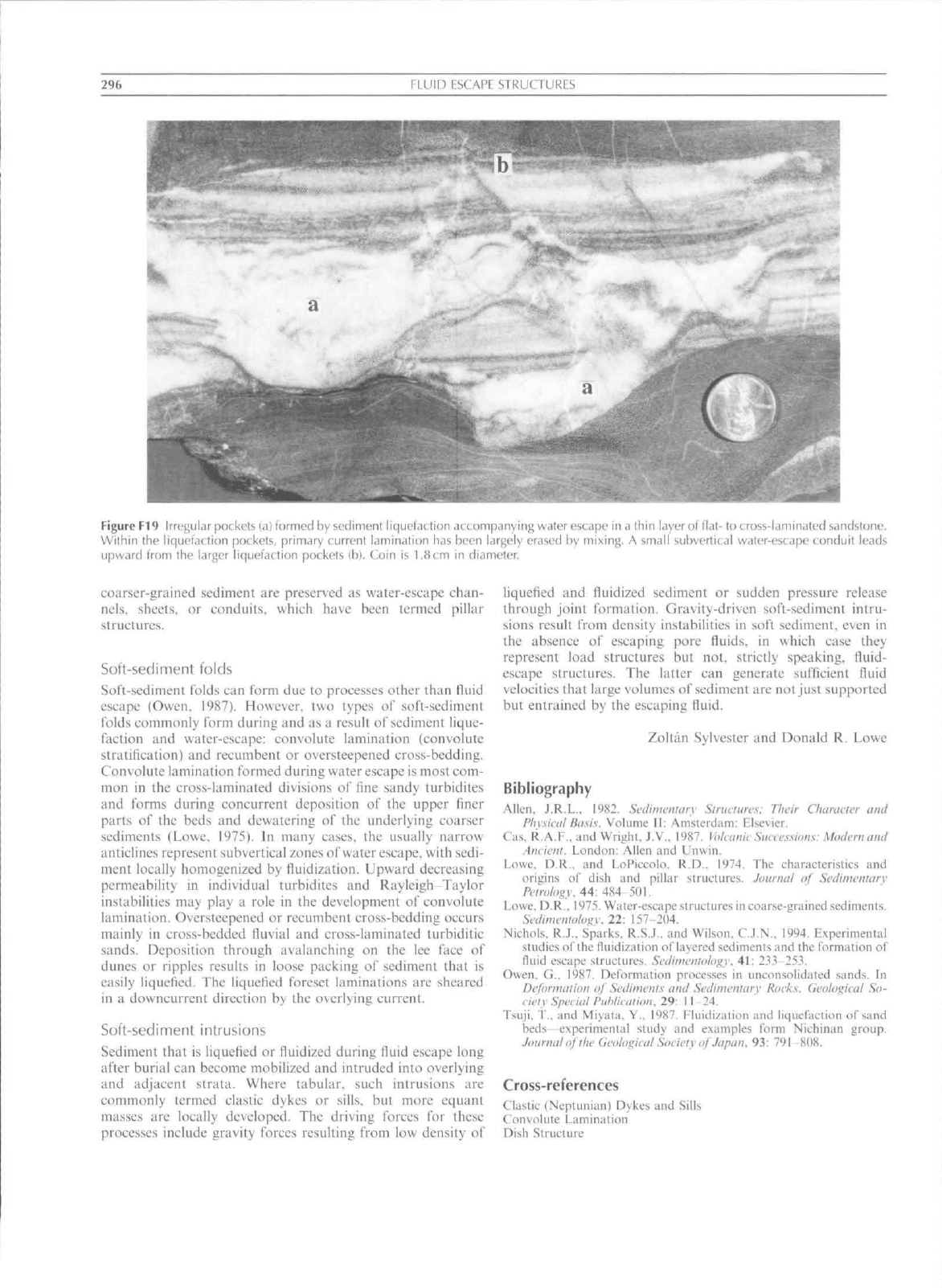
2%
FfUID FSCAPF STRUCTURFS
Figure F19 lirt'i^uLir pockcls uu tutmed by bcdiniunl liquclai,liun .Kt^ompany
ing
water escape in a iliin layer ul Hal- lo cros5-lamlnated sandstone,
Wilhin the liquefaction packets, primary current lamination has been largely erased by mixing. A stnail subvertical water-escape conduit leads
upward from the larger liquefaction pockets (bl. Coin is
l,8ctn
in diameter.
coarser-grained sediment are preserved as water-eseape ehan-
nels,
sheets, or eonduits, whieh have been termed pillar
struetures.
Soft-sediment folds
Soft-seditnent folds can form due to processes other than fluid
eseape (Owen. 1987). However, two types of soft-sediment
folds commonly form during and as a result of sediment lique-
faetion and water-eseape: convolute lamination (convolute
stratifieation) and reeumbent or oversteepened eross-bedding.
Convolute lamination formed during water escape is most eom-
mon in the cross-laminated divisions of fine sandy turbidites
and forms during concurrent deposition of the upper finer
parts of the beds and dewatering of the underlying coarser
sediments (Lowe, 1975). In many cases, the usually narrow
anticlines represent subvertical zones of water eseape. with sedi-
ment loeaily homogenized by fluidization. Upward deereasing
permeability in individual turbidites and Rayleigh-Taylor
instabilities may play a role in the development of convolute
lamination, Oversteepened or reeumbent cross-bedding occurs
mainly in eross-bedded fluvial and cross-laminated turbiditic
sands.
Deposition through avalanehing on the lee face of
dunes or ripples results in loose packing of ,seditnent that is
easily liquefied. The liquefied foreset latninations are sheared
in a downcurrent direetion by the overlying eurrent.
Soft-sediment intrusions
Sediment that is liquefied or fluidized during fluid escape long
after burial ean become mobilized and intruded into overlying
and adjaeent strata. Where tabular, sueh intrusions are
eommonly termed elastic dykes or sills, but more eqiiant
masses are loeaily developed. The driving forces for these
proeesses include gravity forces resulting from low density of
liquefied and fluidized sediment or sudden pressure release
through joint formation. Gravity-driven soft-sediment intru-
sions result from density instabilities in soft sediment, even in
the absence of escaping pore fluids, in which case they
represent load struetures but not, strictly speaking, fluid-
escape structures. The latter can generate sufficient fluid
velocities that large volumes of sediment are not just supported
but entrained by the eseaping fluid.
Zoltan Sylvester and Donald R, Lowe
Bibliography
Allen. J,R,L,, I'JJ^2, Sedimeniary Siruelures: Their Character and
Physical Basis. Volume II: Amstcrdattt: Elsevier.
Cas,
R.A.F,, and Wrighi, J,V,, 1987. IbtcanicSuecessions: Modernand
Ancienl. London: Allen and L'nwin,
Lowe, D,R,, and LoPiecolo, R,D.. 1974. The characteristics and
origitts of dish and pillar slructurcs, Journat oj Sedimentary
Petrotogv. 44:484-501,
Lowe, D,R,,
1
')75,
Water-escape strtietures in coiirse-grairted sedintents.
Sedimeniotogy. 22: 157-204,
Nichols, R,J,, Sparks, R.S,J., and Wilsoti, C,J,N,, 1994, Experitiiental
studies ofthe Hiiidization oi'layered sediments and the fonnation of
fluid escape strtjctures. Sedimentotogy. 41: 2.13 253,
Owen. G,, 1987, Deformation processes in tinconsolidated sands. In
Deformation oj Sediments and Sedimeniary Rocks. Geotogieal So-
eiety
.Speeiat
Puhtieation. 29:
1 I -
24,
Tsuji, T,. and Miyata, Y,, 1987, Fluidization and liquefaction of sand
beds experitnental study and examples form Nichiiian group,
.lournal ojltie Geotogieat Soeiely of Japan. 93: 791 808,
Cross-references
ic (Neptuniiin) Dykes and Sills
Convolute Lamination
Dish Structure
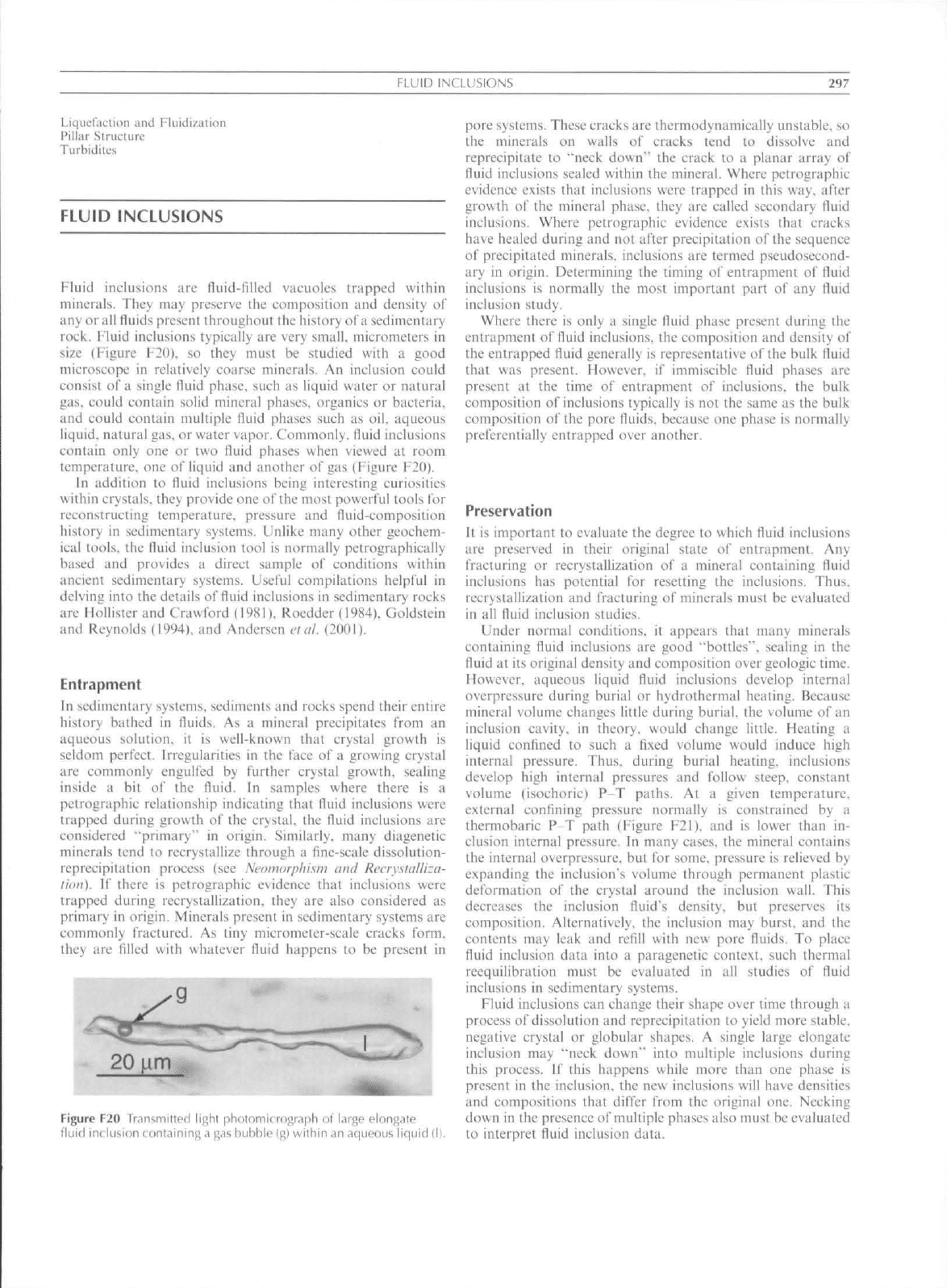
FLUID INCLUSIONS 297
L-iqiicfiiclion
and
F'luidizalinn
Pillar Slriiclurc
Tiirbidiies
FLUID INCLUSIONS
Fluid inclusions
are
fluid-filled vacuoles trapped within
minerals. They
may
preserve
the
composition
and
density
of
any
or
all fluids present throughotit the history
ofa
sedimentary
rock. Fluid inclusions typically
are
very small, micrometers
in
size (Figure F~2()),
so
they musi
be
studied with
a
good
microscope
in
relatively eoarse minerals.
An
inclusion could
consist
ofa
single fluid phase, such
as
liquid water
or
natural
gas.
could contain solid mineral phases, organics
or
bacteria,
and could contain multiple fluid phases such
as oil.
aqueous
liquid, natural gas,
or
water vapor. Commonly, fluid inclusions
contain only
one or two
fluid phases when viewed
at
room
temperature,
one of
liquid
and
another
of gas
(Figure
F20).
In addition
to
fluid inclusions being interesting curiosities
within crystals, they provide
one of
ihe most powerful tools
for
reconstructing temperature, pressure
and
fluid-composition
history
in
sedimentary systems. Unlike many other geochem-
ieal tools,
the
fluid inelusion too!
is
normally petrographically
based
and
provides
a
direct sample
of
conditions within
ancient sedimentary systems. Useful compilations helpful
in
delving into
the
details
of
fluid inclusions
in
sedimentary rocks
are Hollister
and
Crawford (I9S1). Roedder (1984). Goldstein
and Reynolds (1994).
and
Andersen clal. (2001).
Entrapment
In sedimentary systems, sediments
and
rocks spend their entire
history bathed
in
fluids.
As a
mineral precipitates from
an
aqueous solution,
it is
well-known that crystal growth
is
seldom perfect. Irregularities
in the
face
of a
growing crystal
are commonly engulfed
by
further crystal growth, sealing
inside
a bit of the
fluid.
In
samples where there
is a
petrographic relationship indicating that fluid inclusions were
trapped during growth
of the
crystal,
the
lluid inclusions
are
considered "primary"
in
origin. Similarly, many diagenetic
minerals tend
lo
recrystallize through
a
fine-scale dissolution-
reprecipitation process
(see
Neoniorphi.sm
und
Recrystalliza-
lioii).
If
there
is
petrographic evidence that inclusions were
trapped during recrystallization. they
are
also considered
as
primary
in
origin. Minerals present
in
sedimentary systems
are
commonly fractured.
As (iny
micrometer-scale eraeks form,
they
are
tilled with whatever fluid happens
to be
present
in
Figure
F20
Transmitted light photomicrograph
of
large elongate
fluid inclusion containing
a
pas bubble (gl within an aqueou-; liquid
pore systems. These cracks
are
thermodynamically unstable,
so
the minerals
on
walls
of
cracks tend
to
dissolve
and
repreeipitate
to
"neck down"
the
crack
to a
planar array
of
fluid inclusions sealed within
the
tnineral. Where petrographic
evidence exists that inclusions were trapped
in
this
way.
after
growth
of the
mineral phase, they
are
ealled seeondary fluid
inelusions. Where petrographic evidence exists that cracks
have healed during
and not
after precipitation ofthe sequence
of precipitated minerals, inclusions
are
termed pscudosecond-
ary
in
origin. Determining
the
timing
of
entrapment
of
fluid
inclusions
is
normally
the
most important part
of any
fluid
inelusion study.
Where there
is
only
a
single fluid phase present during
the
cntraptiictit
of
fluid inclusions,
the
composition
and
density
o\
the entrapped fluid generally
is
representative ofthe bulk tluid
that
was
present. However,
if
immiseible fluid phases
are
present
at the
tirne
of
entrapment
of
inelusions.
the
bulk
composition
of
inclusions typically
is not the
same
as the
bulk
composition
of
the pore fluids, because
one
phase
is
normally
preferentially entrapped over another.
Preservation
It
is
important
to
evaluate
the
degree
to
which fluid inclusions
are preserved
in
their original state
o\'
entraptnent.
Any
fracturing
or
recrystallization
of a
mineral containing fluid
inclusions
has
potential
for
resetting
the
inclusions. Thus.
recr>stallization
and
IVacturing
of
tninerals must
be
evaluated
in
all
fluid inclusion studies.
Under normal conditions,
it
appears that many tiiinerals
containing fluid inclusions
are
good "bottles", sealing
in the
tluid
at its
original density
and
composition over geologic time.
However, aqueous liquid fluid inclusions develop internal
overpressure during burial
or
hydrothermal heating. Because
mineral volutne changes little during burial,
the
volutne
of an
inclusion cavity,
in
theory, would change little. Heating
a
liquid confined
to
such
a
fixed volume would induce high
internal pressure. Thus, during burial heating, inclusions
develop high internal pressures
and
follow steep, constant
volume (isoehoric)
P-T
paths.
At a
given tetnperature.
external confining pressure normally
is
constrained
by a
thermobarie
P T
path (Figure
F21). and is
lower than
in-
clusion internal pressure.
In
many cases,
the
tnineral contains
Ihe internal overpressure,
but for
some, pressure
is
relieved
by
expanding
the
inclusion's volume through permanent plastic
deformation
of the
crystal around
the
inclusioti wall. This
decreases
the
inclusion fluid's density,
but
preserves
its
composition. Alternatively,
the
inclusion
may
burst,
and the
contents
may
leak
and
refill with
new
pore fluids.
To
place
fluid inclusion data into
a
paragenetic context, such thermal
reequilibration must
be
evaluated
in all
studies
of
fluid
inclusions
in
sedimentary systems.
Fluid inclusions
can
change their shape over time through
a
process
of
dissolution
and
reprecipitation
to
yield more stable,
negative crystal
or
globular shapes.
A
single large elongate
inclusion
may
"neck down" into multiple inclusions during
this process.
If
this happens uhile more than
one
phase
is
present
in the
inelusion.
the new
inclusions will have densities
and compositions that differ frotn
the
original
one.
Necking
down
in the
presence
of
multiple phases also must be evaluated
to interpret fluid inclusion data.
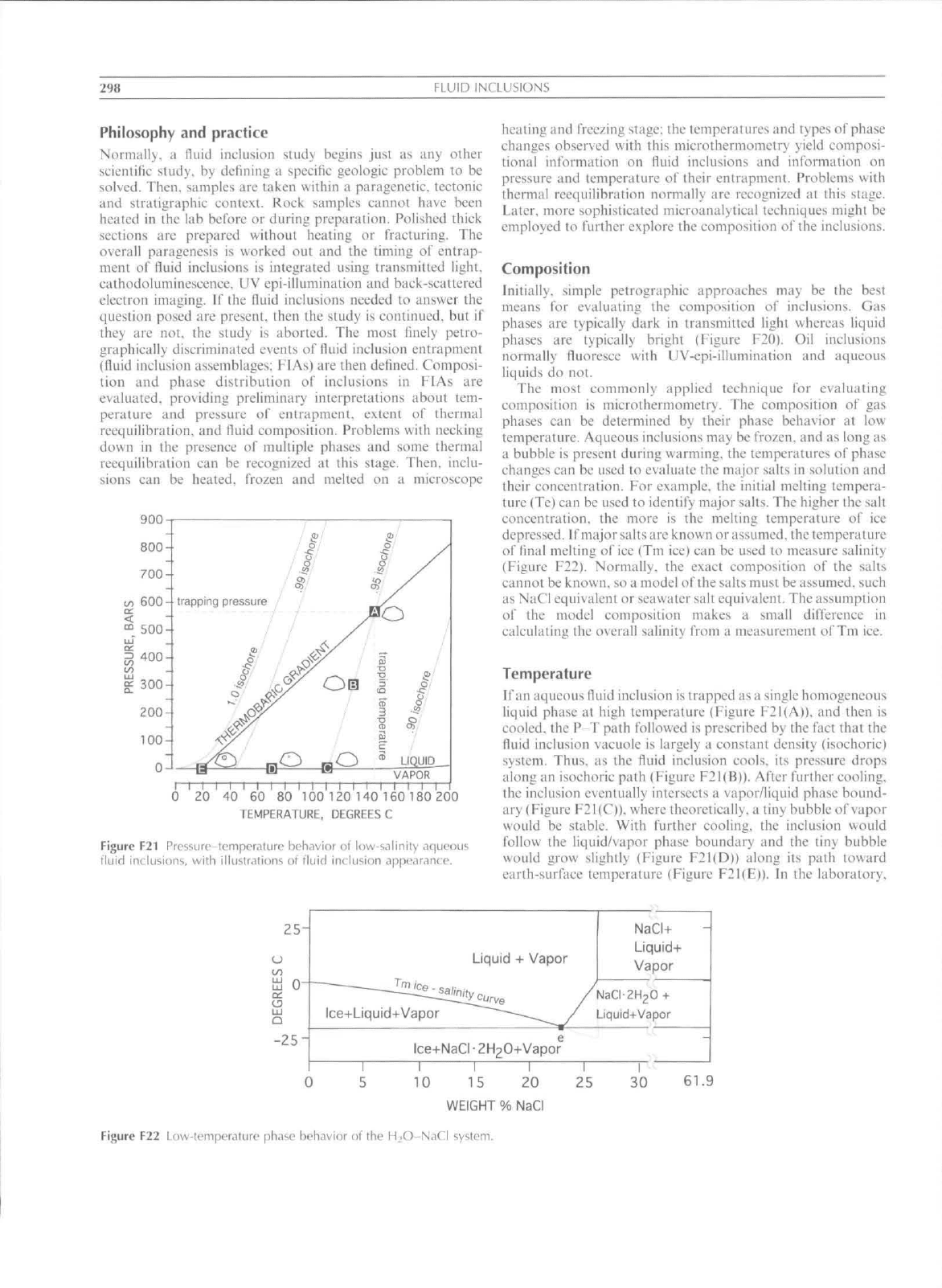
298
FIUID INCLUSIONS
Philosophy and practice
Normally, a fluid inclusion study begins just as any olher
scientiflc study, by defining a speciiic geologic problem to be
solved. Then, samples are taken within a paragenetic. teetonie
and stratigraphie context. Rock samples cannot have been
heated in the lab before or during preparation. Polished thick
sections are prepared without heating or fracturing. The
overall paragenesis is worked out and the timing of entrap-
ment oi' fluid inclusions is integrated usmg transmitted light.
eathodoluminescence. UV epi-iliutnination and back-scattered
electron imaging. If the fluid inclusions needed to answer the
question posed are present, then the study is continued, but if
they are not, the study is aborted. The most finely petro-
graphically discriminated events of fluid inclusion entrapment
(fluid inclusion assemblages; FIAs) are then defined. Cotnposi-
tion atid phase distribution of inclusions in FIAs are
evaluated, providing prelitninary interpretations about tem-
perature and pressure of entraptnent. extent of thertnal
reequilibration. and fluid cotnposition. Problems with neckitig
down in the presence of multiple phases and some thermal
reequilibration can be recognized at this stage. Then, inclu-
sions can be heated, frozen and melted on a microscope
900
1
I I I I I I I I I I I I I
0 20 40 60 80 100120140160180200
TEMPERATURE. DEGREESC
Figure F21 Pressure-temperature behavior
QI
low-salinity aqueous
fluid inclusions, with illustrations ot" lluid inclusion appearance.
heating and freezing stage; the temperatures and types of phase
changes observed with this microthermometry yield composi-
tional intbrmation on fluid inclusions and infortnation on
pressure and tetnperature oi' their entrapment. Probletns with
thertnal reequilibratioti normally are recognized al this stage.
Later, more sophisticated tnicroanalytical techniques might be
employed to further explore the composition ofthe inclusions.
Composition
Initially, simple petrogt"aphic approaches may be the best
tncans for evaluating the composition of inclusions. Gas
phases are typically dark iti transmitted light whereas liquid
phases are typically bright (Figure F20). Oii inclusions
nonnally fluoresce with UV-epi-illumination and aqueous
liquids do not.
The most commonly applied technique for evaluating
composition is microthermometry. The composition of gas
phases can be detennined by their phase behavior at low
temperature. Aqueous inclusions may be frozen, and as long as
a bubble is present during warming, the temperatures of phase
changes can be used to evaluate the tnajor salts in solution and
their concentration. For exatnple. the itiitial tncltitig tempera-
ture (Te) can be used to identify major salts. The higher the salt
eoncetitration. the tnore is the melting temperature ol" ice
depressed. If major salts are known or assumed, the temperature
of tinal melting of ice (Tm ice) ean be used to measure salinity
(Figure F22). Normally, the exact eomposition of the salts
cannot be knowti. so a tiiodel ofthe salts must be assumed, such
as NaCI equivalent or seawater salt equivalent. The assumption
oi' the tnodel cotnposition tnakes a small difference in
calculating the overall salinity tVoni a measurement of Ttn ice.
Temperature
If an aqueous tluid inclusion is trapped as
a
sitigle homogeneous
liquid phase at high temperature (Figure F2UA)). and then is
cooled, the P-T path followed is prescribed by the fact that the
fluid iticlusion vacuole is largely a constant density (isoehoric)
systetn. Thus, as the fluid incUtsion cotils. ils pressure drops
along an isoehoric path (Figure F21(B)). Afier further cooling,
the inelusion eventually interseets a vapor/liquid phase bound-
ary (Figure F21(C)), where theoretically, a tiny bubble of vapor
woLtId be stable. With further cooling, the inclusion would
follow the liquid/vapor phase boundary and the tiny bubble
would grow slightly (Figure F21(D)) along its path toward
earth-surface tetnperature (Figure F2l(F)). In the laboratory.
10 15 20
WEIGHT % NaCI
25 30
61.9
Figure F22 Low-lemperaturc phase behavior of the H.|O-NaCI systetn.
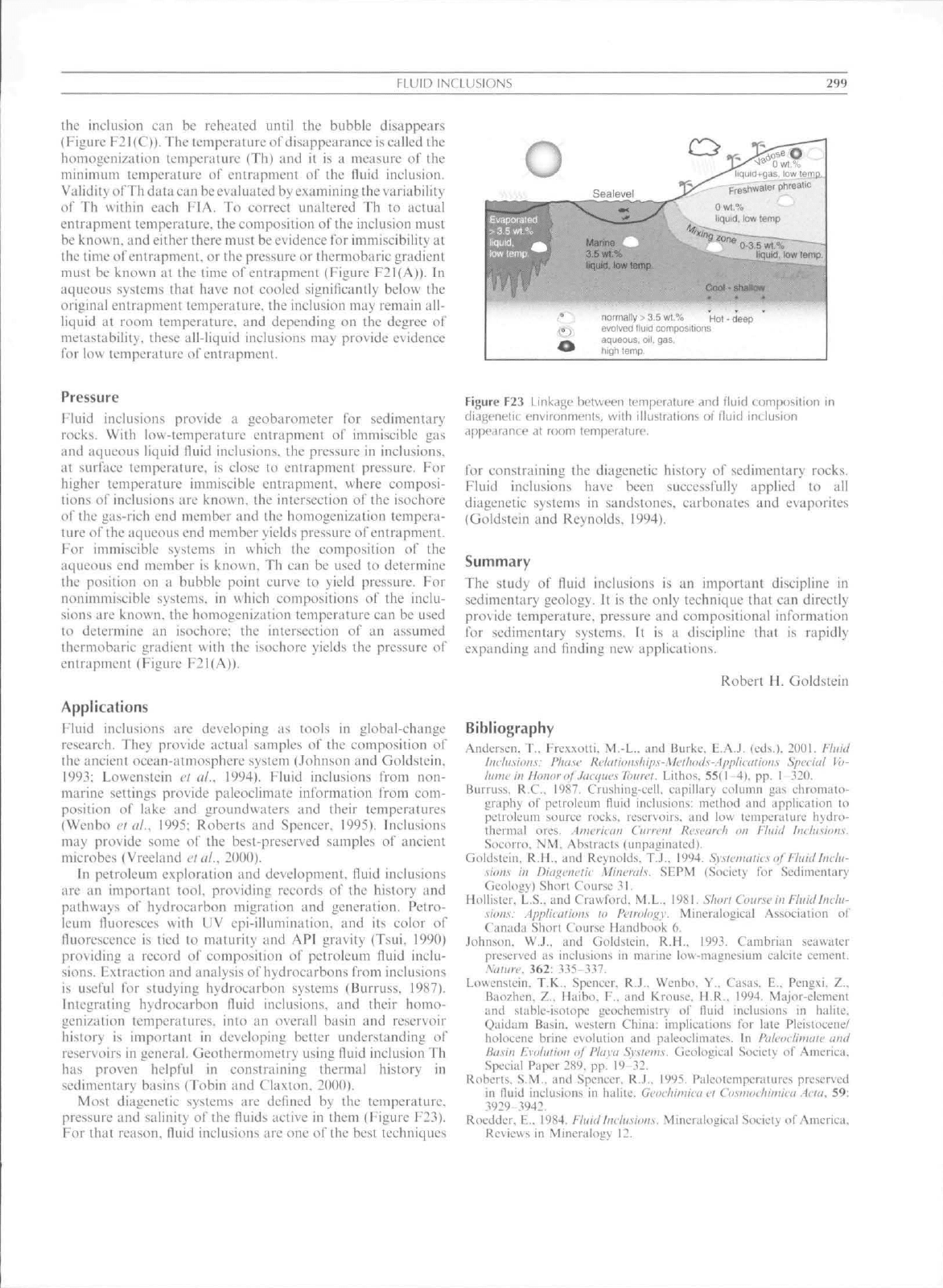
FLUID INCLUSIONS
299
the inclusion can be reheated until the bubble disappears
(Figure F21(C)). The temperature of disappearance is ealled the
homogenization temperature (Th) and it is a measure of the
mitiitnutn tetnperature of entraptnent of the fluid inclusion.
Valid iu ofTh data can be evaluated by exatnining the variability
of Th within each FIA. To correct unaltered Th to actual
entraptnetit tetnperature. the composition ofthe iticlusioti tnust
be kttow n. and either there must be evidence for itntniscibility at
the titne of entrapment, or the pressure or thermobarie gradient
must be known at the time of entrapment (Figure F21(A)). In
aqueous systems that have not cooled signilicantly below the
original entraptnent temperature, the inclusion tnay remain all-
liquid al room tetnperature. and depending oti the degree oi
mctastability. these all-liquid inclusions may provide evidetiee
for low temperature of entrapment.
normally > 3.5 wt.% Hot • deep
evolved fluid compositions
aqueous, oil. gas.
high temp.
Pressure
Fluid inclusions provide a geobarometer for sedimentary
rocks.
With lovv-temperature entraptnent of immiscible gas
and aqueous liquid Huid iticlusions. the pressure in inclusions,
at surface temperature, is elose to etitrapment pressut"e. For
higher temperature itnmiscible entraptnetit. uherc cotnposi-
tions o\' inclusions are known, the intersection o\' the isochore
ofthe gas-rich end member and the homogenization tetnpera-
ture ofthe aqueous end member yields pressure of entrapment.
For immiscible systems In which the composition of the
aqueous end member is known. Th can be used to determine
the position on a bubble point curve to yield pressure. For
nonitnmiscible systetns. in which cotnposltions of the inclu-
sions are known, the homogenization tetnperature cati be used
to determitie an isoehore: the intersection oi' ati assutned
thettnobaric gradient with the isochore yields the pressure o\'
entrapment (Figure F21(A)).
Applications
Fluid inclusions are developing as tools in global-ehange
reseatch. They provide actual satnples of the cotnposition of
the ancient oceati-atmosphere systetn (.lohnson and Goldsteiti.
\99}:
Lowenstein ei al., 1994). Fluid inclusions trom tion-
tnarine settings provide paleoclitnate information frotn com-
position of lake and groundwaters and their temperatures
(Wenbo etal.. 1995: Roberts and Spencer. 1995). Inclusions
may provide some of the best-preserved satnples of ancient
microbes (Vreeland a ai. 2000).
In pctroleutn exploration and development, fluid inclusions
are an important tool, providitig records o\' the history and
pathways of hydrocarbon tnigration and generation. Petro-
lcutn tluoresces with UV cpi-illumination. and its color of
tluorescence is tied to maturity and API gravity (Tsui. 1990)
providing a reeord of cotnposition of petroleum fluid inclu-
sions.
Extraction and analysis ol'hydrocarbons frotn inclusions
is useful for studying hydrocarbon systetns (Burruss. 1987).
Ititegratitig hydrocarbon lluid iticlusions. and their hotno-
getii/atioti tetnperatures. into an overall bastn and reservotr
hislor\ is iinportatU in developing better understanding o\'
reservoirs in general. Geothermotnetry using lluid inclusioti Th
has proven helpftil in constraining thermal history in
seditnentary basins (Tobin and C'laxton. 2000).
Most diagenetic systems are defined by the temperature,
pressure and salinity of the fluids active in them (Figure F23).
For that reason. lUtid inclusiotts are one ofthe best techniques
Figure F23 Linkage between temperature and tluid composition in
diagenetit environments, with illustrations ot fluid inclusion
appearance at room temperature.
tor constraining the diagenetic history of seditnentary rocks.
Fluid iticlusiotis have been successfully applied to all
diagenetic systetns in sandstoties. carbonates and evaporites
(Goldstein and Reynolds. 1994).
Summary
The study of fluid inclusions is an important discipline in
seditnentary geology. It is the only techniqitc that can directly
provide tetnperature. pressure and compositional information
for sedimentary systems. It is a diseipline that is rapidly
expanding and finding new applications.
Robert H. Goldstein
Bibliography
.\iidcrsL-n. T.. lri:x\otti. M.-L.. iind
Biirkf.
E.A.J. (eds.). 2001. t'ltiiil
IniliisiDiis: Phase
Rchiii<iii.shii).\-\fc!liiiil.\-.ti>pli<anoi!.s
Special Vc-
liiinc in
Hiiiior
of .hiaiiics Toiiivt. Lithos, 55(
1
4). pp. 1 320.
Burruss. R.C.
['i^l.
Critshing-L-cll. capillary columti gas ciiromato-
graphy of petroleum lluid inclusions; method and application to
petroleum source rot.ks. reservoirs, and low temperature hydro-
thertnal ores. Anurictin CiirrciU Rf.scairh on Fluid Inchi.sions.
Socorro. NM. Abstracts (tjnpaginatcd).
Cioldstein. R.H.. and Reynolds. T.J.. 1994. Syslcnuilics of FliiitlIiulu-
,\uiii.\ in Dkiiiencnc Minerals. SEPM (Society for Sedimetitary
(k'ologyl Short Course 31.
Hollislcr. L.S.. and Crawford. M.L.. I98i. Shoil Course in Fhiki Inclu-
sions: .Applicalioiis In Pe!n>loi;y. Mltieralogical Association of
Canada Short Course Handbook 6.
.lohnson. W.J.. and Cioldstein. R.H.. 1993. Cambrian seawater
preserved ;!s inclusions in niiiriiie lou-magnesiutn ealeite cement.
\ulurc. 362: 335-337.
Lowenstein. T.K.. Spencer. R.J.. Wenbo. Y.. Casas. E.. Peng.vi. Z..
Bao/hen. Z.. Hiiiho. I-., and Krouse. IfR.. 1994. Major-eiement
;ind stable-isotope geoehemistry of fluid iticlusions in halite.
Uiiidam Basiti. western China: implications tor late Pleistocene/
hoiocene brine evolution and paleoclimales. In Paleocliiiune and
Ha.sin
Evolution of Plava Systems. Cieolonieal Soeiety of America.
Speeiiil Paper 2^9. pp.' 19-32.
Roberts. S.M.. and Spencer. R.J.. 1995. Paleotemperatures preserved
in tluid inclusions in halite. Gcoelunucti cl
Co.Mnncliiniica
Ada. 59:
3929 .1942.
Roedder. F.. 1984, Fluid
IIH
lusions. Mineralogical Society of America.
Reviews in Mineralogy 12.
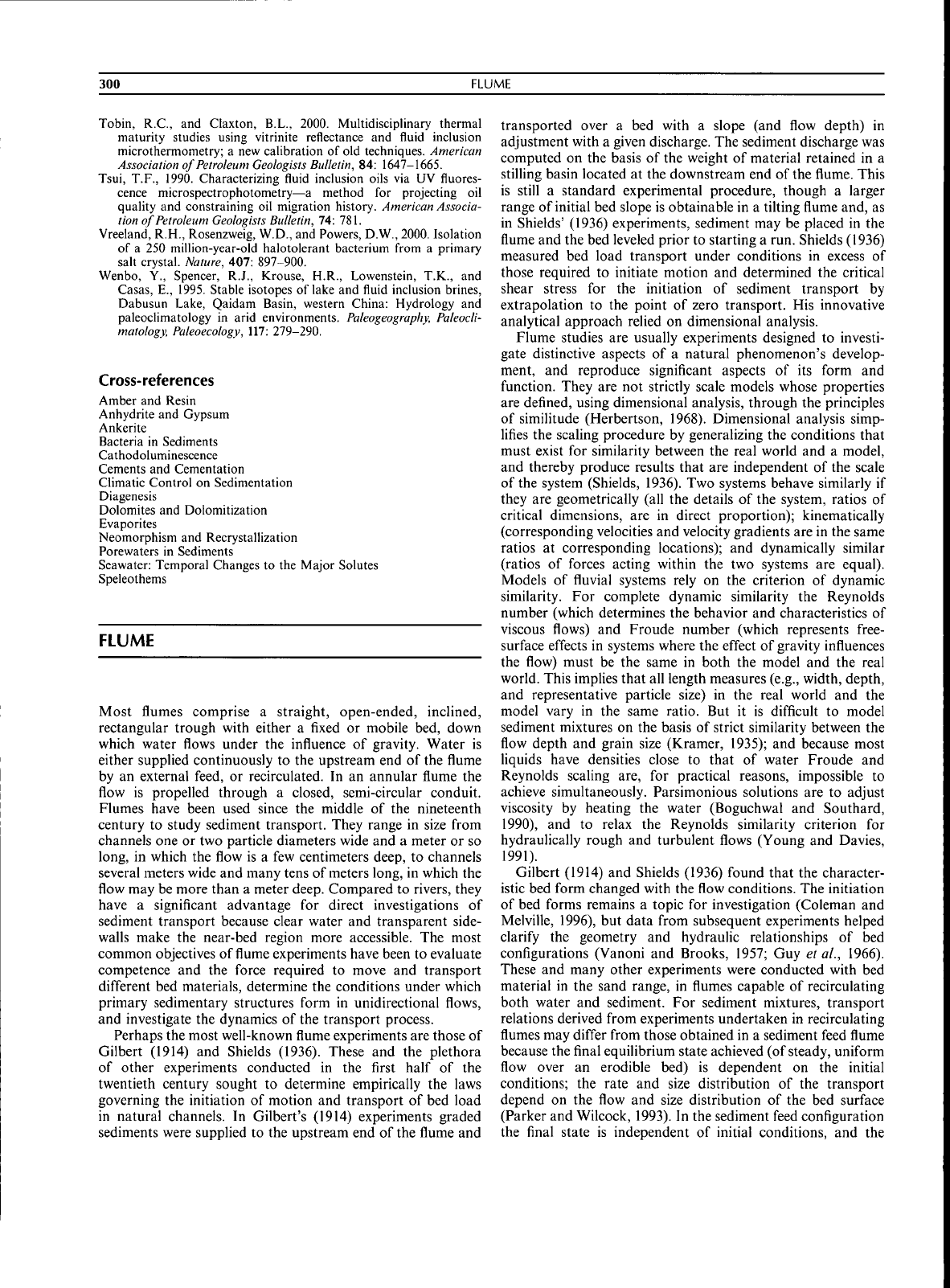
300 FLUME
Tobin, R.C., and Claxton, B.L., 2000. Multidisciplinary thermal
maturity studies using vitrinite reflectance and fluid inclusion
microthermometry; a new calibration of old techniques. American
Association of Petroleum Geologisls Bulletin, 84: 1647-1665.
Tsui, T.F., 1990. Characterizing fluid inclusion oils via UV fluores-
cence microspectrophotometry—a method for projecting oil
quality and constraining oil migration history. American Associa-
tion of Petroleum Geologists Bulletin, 74; 781.
Vreeland, R.H., Rosenzweig, W.D., and Powers, D.W., 2000. Isolation
of a 250 million-year-old halotolerant bacterium from a primary
salt crystal. Nature, 407: 897-900.
Wenbo, Y., Spencer, R.J., Krouse, H.R., Lowenstein, T.K., and
Casas,
E., 1995. Stable isotopes of lake and fluid inclusion brines,
Dabusun Lake, Qaidam Basin, western China: Hydrology and
paleoclimatology in arid environments. Paleogeography. Paleocli-
matology, Paleoecology, 117: 279-290.
Cross-references
Amber and Resin
Anhydrite and Gypsum
Ankerite
Bacteria in Sediments
Cathodoluminescence
Cements and Cementation
Climatic Control on Sedimentation
Diagenesis
Dolomites and Dolomitization
Evaporites
Neomorphism and Recrystallization
Porewaters in Sediments
Seawater: Temporal Changes to the Major Solutes
Speleothems
FLUME
Most flumes comprise a straight, open-ended, inclined,
rectangular trough with either a fixed or mobile bed, down
which water flows under the influence of gravity. Water is
either supplied continuously to the upstream end of the flume
by an external feed, or recirculated. In an annular flume the
flow is propelled through a closed, semi-circular conduit.
Flumes have been used since the middle of the nineteenth
century to study sediment transport. They range in size from
channels one or two particle diameters wide and a meter or so
long, in which the flow is a few centimeters deep, to channels
several meters wide and many tens of meters long, in which the
flow may be more than a meter deep. Compared to rivers, they
have a significant advantage for direct investigations of
sediment transport because clear water and transparent side-
walls make the near-bed region more accessible. The most
common objectives of flume experiments have been to evaluate
competence and the force required to move and transport
different bed materials, determine the conditions under which
primary sedimentary structures form in unidirectional flows,
and investigate the dynamics of the transport process.
Perhaps the most well-known flume experiments are those of
Gilbert (1914) and Shields (1936). These and the plethora
of other experiments conducted in the first half of the
twentieth century sought to determine empirically the laws
governing the initiation of motion and transport of bed load
in natural channels. In Gilbert's (1914) experiments graded
sediments were supplied to the upstream end of the flume and
transported over a bed with a slope (and flow depth) in
adjustment with a given discharge. The sediment discharge was
computed on the basis of the weight of material retained in a
stilling basin located at the downstream end of the flume. This
is still a standard experimental procedure, though a larger
range of initial bed slope is obtainable in a tilting flume and, as
in Shields' (1936) experiments, sediment may be placed in the
flume and the bed leveled prior to starting a run. Shields (1936)
measured bed load transport under conditions in excess of
those required to initiate motion and determined the critical
shear stress for the initiation of sediment transport by
extrapolation to the point of zero transport. His innovative
analytical approach relied on dimensional analysis.
Flume studies are usually experiments designed to investi-
gate distinctive aspects of a natural phenomenon's develop-
ment, and reproduce significant aspects of its form and
function. They are not strictly scale models whose properties
are defined, using dimensional analysis, through the principles
of similitude (Herbertson, 1968). Dimensional analysis simp-
lifies the scaling procedure by generalizing the conditions that
must exist for similarity between the real world and a model,
and thereby produce results that are independent of the scale
of the system (Shields, 1936). Two systems behave similarly if
they are geometrically (all the details of the system, ratios of
critical dimensions, are in direct proportion); kinematically
(corresponding velocities and velocity gradients are in the same
ratios at corresponding locations); and dynamically similar
(ratios of forces acting within the two systems are equal).
Models of fluvial systems rely on the criterion of dynamic
similarity. For complete dynamic similarity the Reynolds
number (which determines the behavior and characteristics of
viscous flows) and Froude number (which represents free-
surface effects in systems where the effect of gravity influences
the flow) must be the same in both the model and the real
world. This implies that all length measures (e.g., width, depth,
and representative particle size) in the real world and the
model vary in the same ratio. But it is difficult to model
sediment mixtures on the basis of strict similarity between the
flow depth and grain size (Kramer, 1935); and because most
liquids have densities close to that of water Froude and
Reynolds scaling are, for practical reasons, impossible to
achieve simultaneously. Parsimonious solutions are to adjust
viscosity by heating the water (Boguchwal and Southard,
1990),
and to relax the Reynolds similarity criterion for
hydraulically rough and turbulent flows (Young and Davies,
1991).
Gilbert (1914) and Shields (1936) found that the character-
istic bed form changed with the flow conditions. The initiation
of bed forms remains a topic for investigation (Coleman and
Melville, 1996), but data from subsequent experiments helped
clarify the geometry and hydraulic relationships of bed
configurations (Vanoni and Brooks, 1957; Guy etal., 1966).
These and many other experiments were conducted with bed
material in the sand range, in flumes capable of recirculating
both water and sediment. For sediment mixtures, transport
relations derived from experiments undertaken in recirculating
flumes may differ from those obtained in a sediment feed flume
because the final equilibrium state achieved (of steady, uniform
flow over an erodible bed) is dependent on the initial
conditions; the rate and size distribution of the transport
depend on the flow and size distribution of the bed surface
(Parker and Wilcock, 1993). In the sediment feed configuration
the final state is independent of initial conditions, and the
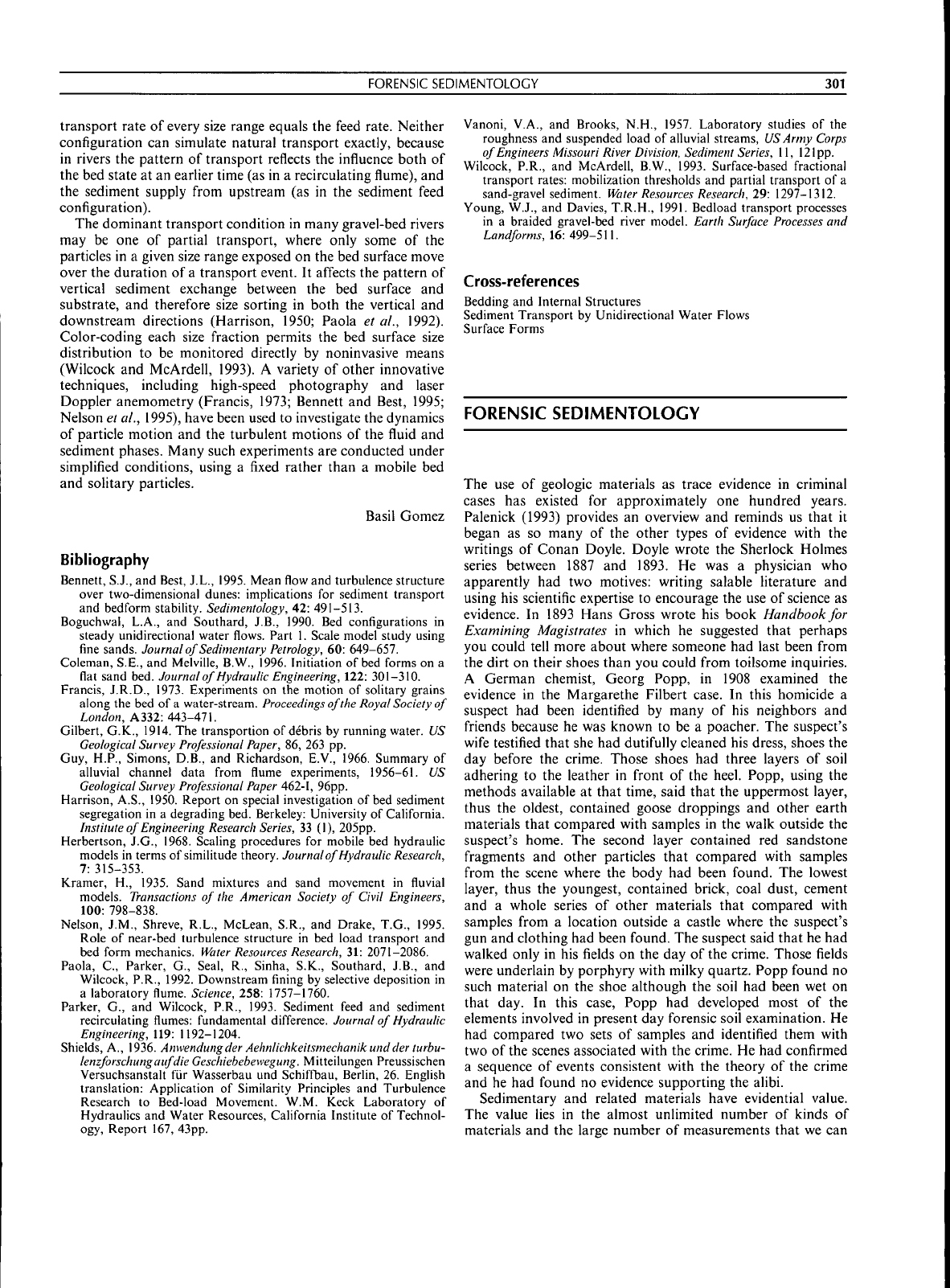
FORENSIC SEDIMENTOLOCY 301
transport rate of every size range equals the feed rate. Neither
configuration can simulate natural transport exactly, because
in rivers the pattern of transport reflects the influence both of
the bed state at an earlier time (as in a recirculating flume), and
the sediment supply from upstream (as in the sediment feed
configuration).
The dominant transport condition in many gravel-bed rivers
may be one of partial transport, where only some of the
particles in a given size range exposed on the bed surface move
over the duration of a transport event. It affects the pattern of
vertical sediment exchange between the bed surface and
substrate, and therefore size sorting in both the vertical and
downstream directions (Harrison, 1950; Paola et al., 1992).
Color-coding each size fraction permits the bed surface size
distribution to be monitored directly by noninvasive means
(Wilcock and McArdell, 1993). A variety of other innovative
techniques, including high-speed photography and laser
Doppler anemometry (Francis, 1973; Bennett and Best, 1995;
Nelson et al., 1995), have been used to investigate the dynamics
of particle motion and the turbulent motions of the fluid and
sediment phases. Many such experiments are conducted under
simplified conditions, using a fixed rather than a mobile bed
and solitary particles.
Basil Gomez
Bibliography
Bennett, S.J., and Best, J.L., 1995. Mean flow and turbulence structure
over two-dimensional dunes: implications for sediment transport
and bedform stability. Sedimentology, 42: 491-513.
Boguchwal, L.A., and Southard, J.B., 1990. Bed configurations in
steady unidirectional water flows. Part 1. Scale model study using
fine
sands.
Journal of Sedimentary Petrology, 60: 649-657.
Coleman, S.E., and Melville, B.W., 1996. Initiation of bed forms on a
flat sand bed. Journal of Hydraulic Engineering, 122: 301-310.
Francis, J.R.D., 1973. Experiments on the motion of solitary grains
along the bed of a water-stream.
Proceedings
of the Royal Society of
London, A332:
443-471.
Gilbert, G.K., 1914. The transportion of debris by running water. CAS
Geological Survey Professional Paper, 86, 263 pp.
Guy, H.P., Simons, D.B., and Richardson, E.V., 1966. Summary of
alluvial channel data from flume experiments,
1956-61.
US
Geological Survey Professional Paper
462-1,
96pp.
Harrison, A.S., 1950. Report on special investigation of bed sediment
segregation in a degrading bed. Berkeley: University of Califomia.
Institute of Engineering Research Series, 33 (1), 205pp.
Herbertson, J.G., 1968. Scaling procedures for mobile bed hydraulic
models in terms of similitude theory. Journal of Hydraulic Research,
7:
315-353.
Kramer, H., 1935. Sand mixtures and sand movement in fluvial
models. Transactions of the American Society of Civil Engineers,
100:
798-838.
Nelson, J.M., Shreve, R.L., McLean, S.R., and Drake, T.G., 1995.
Role of near-bed turbulence structure in bed load transport and
bed form mechanics. Water Resources Research, 31: 2071-2086.
Paola, C, Parker, G., Seal, R., Sinha,
S.K..,
Southard, JR., and
Wilcock, P.R., 1992. Downstream fining by selective deposition in
a laboratory flume. Science, 258: 1757-1760.
Parker, G., and Wilcock, P.R., 1993. Sediment feed and sediment
recirculating flumes: fundamental difference. Journal of Hydraulic
Engineering, n9\ 1192-1204.
Shields, A., 1936. Anwendungder Aehnlichkeitsmechanikundder turbu-
lenzforschungaufdie Geschiebebewegung. Mitteilungen Preussischen
Versuchsanstalt fur Wasserbau und Schiffbau, Berlin, 26. English
translation: Application of Similarity Principles and Turbulence
Research to Bed-load Movement. W.M. Keck Laboratory of
Hydraulics and Water Resources, California Institute of Technol-
ogy, Report 167, 43pp.
Vanoni, V.A., and Brooks, N.H., 1957. Laboratory studies of the
roughness and suspended load of alluvial streams, US Army Corps
of Engineers Missouri River Division, Sediment Series, 11, 121pp.
Wilcock, P.R., and McA.rdell, B.W., 1993. Surface-based fractional
transport rates: mobilization thresholds and partial transport of a
sand-gravel sediment. Water Resources Research, 29: 1297-1312.
Young, W.J., and Davies, T.R.H., 1991. Bedload transport processes
in a braided gravel-bed river model. Earth Surface Processes and
Landforms, 16:
499-511.
Cross-references
Bedding and Internal Structures
Sediment Transport by Unidirectional Water Flows
Surface Forms
FORENSIC SEDIMENTOLOGY
The use of geologic materials as trace evidence in criminal
cases has existed for approximately one hundred years.
Palenick (1993) provides an overview and reminds us that it
began as so many of the other types of evidence with the
writings of Conan Doyle. Doyle wrote the Sherlock Holmes
series between 1887 and 1893. He was a physician who
apparently had two motives: writing salable literature and
using his scientific expertise to encourage the use of science as
evidence. In 1893 Hans Gross wrote his book Handbook for
Examining Magistrates in which he suggested that perhaps
you could tell more about where someone had last been from
the dirt on their shoes than you could from toilsome inquiries.
A German chemist, Georg Popp, in 1908 examined the
evidence in the Margarethe Filbert case. In this homicide a
suspect had been identified by many of his neighbors and
friends because he was known to be a poacher. The suspect's
wife testified that she had dutifully cleaned his dress, shoes the
day before the crime. Those shoes had three layers of soil
adhering to the leather in front of the heel. Popp, using the
methods available at that time, said that the uppermost layer,
thus the oldest, contained goose droppings and other earth
materials that compared with samples in the walk outside the
suspect's home. The second layer contained red sandstone
fragments and other particles that compared with samples
from the scene where the body had been found. The lowest
layer, thus the youngest, contained brick, coal dust, cement
and a whole series of other materials that compared with
samples from a location outside a castle where the suspect's
gun and clothing had been found. The suspect said that he had
walked only in his fields on the day of the crime. Those fields
were underlain by porphyry with milky quartz. Popp found no
such material on the shoe although the soil had been wet on
that day. In this case, Popp had developed most of the
elements involved in present day forensic soil examination. He
had compared two sets of samples and identified them with
two of the scenes associated with the crime. He had confirmed
a sequence of events consistent with the theory of the crime
and he had found no evidence supporting the alibi.
Sedimentary and related materials have evidential value.
The value lies in the almost unlimited number of kinds of
materials and the large number of measurements that we can
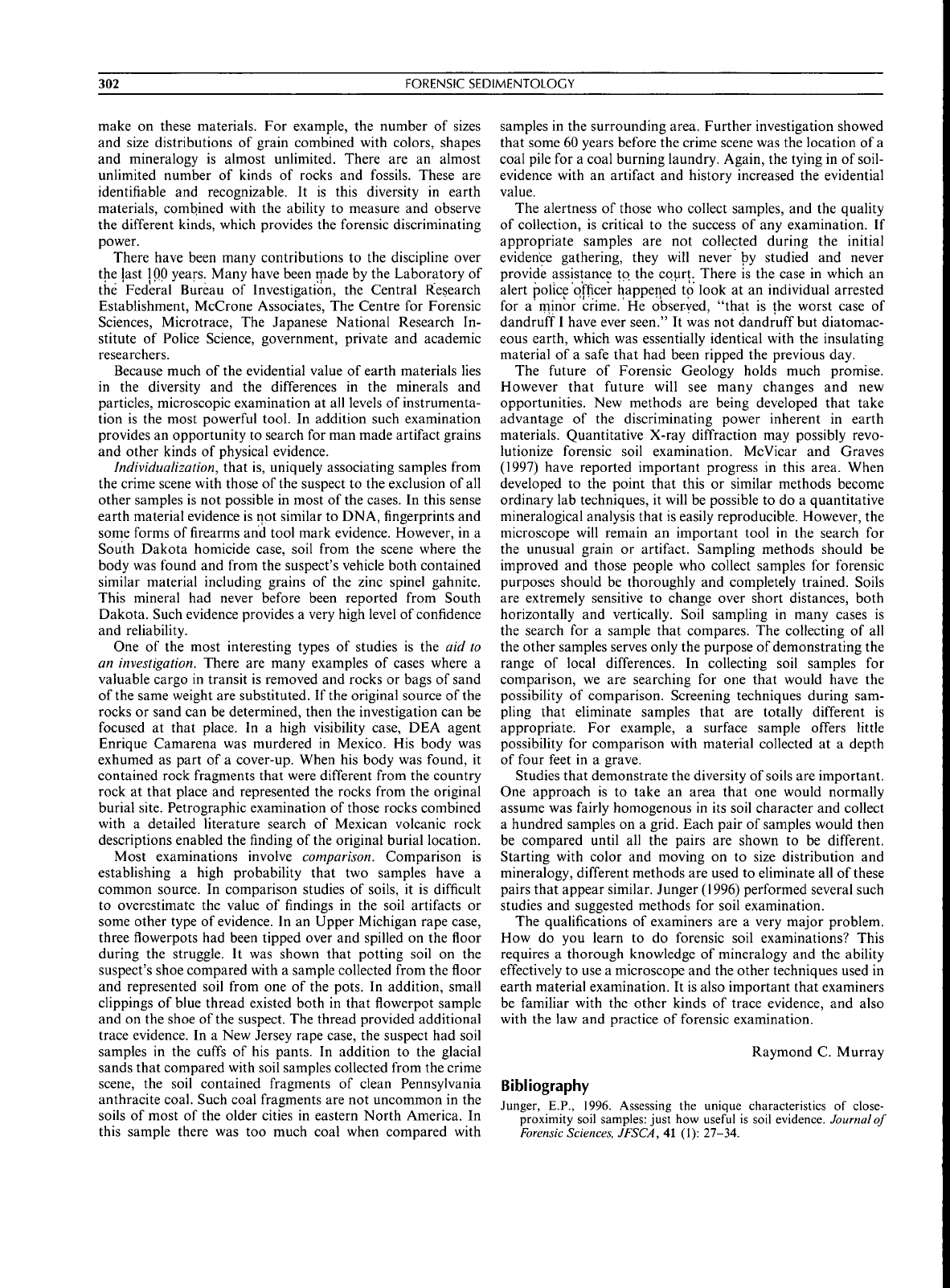
302
FORENSIC SEDIMENTOLOCY
make on these materials. For example, the number of sizes
and size distributions of grain combined with colors, shapes
and mineralogy is almost unlimited. There are an almost
unlimited number of kinds of rocks and fossils. These are
identifiable and recognizable. It is this diversity in earth
materials, combined with the ability to measure and observe
the different kinds, which provides the forensic discriminating
power.
There have been many contributions to the discipline over
the jast jPP years. Many have been made by the Laboratory of
the Federal Bureau of Investigation, the Central Research
Establishment, McCrone Associates, The Centre for Forensic
Sciences, Microtrace, The Japanese National Research In-
stitute of Police Science, government, private and academic
researchers.
Because much of the evidential value of earth materials lies
in the diversity and the differences in the minerals and
particles, microscopic examination at all levels of instrumenta-
tion is the most powerful tool. In addition such examination
provides an opportunity to search for man made artifact grains
and other kinds of physical evidence.
Individualization, that is, uniquely associating samples from
the crime scene with those of the suspect to the exclusion of all
other samples is not possible in most of the cases. In this sense
earth material evidence is riot similar to DNA, fingerprints and
some forms of firearms and tool mark evidence. However, in a
South Dakota homicide case, soil from the scene where the
body was found and from the suspect's vehicle both contained
similar material including grains of the zinc spinel gahnite.
This mineral had never before been reported from South
Dakota. Such evidence provides a very high level of confidence
and reliability.
One of the most interesting types of studies is the aid to
an investigation. There are many examples of cases where a
valuable cargo in transit is removed and rocks or bags of sand
ofthe same weight are substituted. If the original source ofthe
rocks or sand can be determined, then the investigation can be
focused at that place. In a high visibility case, DEA agent
Enrique Camarena was murdered in Mexico. His body was
exhumed as part of a cover-up. When his body was found, it
contained rock fragments that were different from the country
rock at that place and represented the rocks from the original
burial site. Petrographic examination of those rocks combined
with a detailed literature search of Mexican volcanic rock
descriptions enabled the finding of the original burial location.
Most examinations involve comparison. Comparison is
establishing a high probability that two samples have a
common source. In comparison studies of soils, it is difficult
to overestimate the value of findings in the soil artifacts or
some other type of evidence. In an Upper Michigan rape case,
three flowerpots had been tipped over and spilled on the floor
during the struggle. It was shown that potting soil on the
suspect's shoe compared with a sample collected from the floor
and represented soil from one of the pots. In addition, small
clippings of blue thread existed both in that flowerpot sample
and on the shoe of the suspect. The thread provided additional
trace evidence. In a New Jersey rape case, the suspect had soil
samples in the cuffs of his pants. In addition to the glacial
sands that compared with soil samples collected from the crime
scene, the soil contained fragments of clean Pennsylvania
anthracite coal. Such coal fragments are not uncommon in the
soils of most of the older cities in eastern North America. In
this sample there was too much coal when compared with
samples in the surrounding area. Further investigation showed
that some 60 years before the crime scene was the location of a
coal pile for a coal burning laundry. Again, the tying in of soil-
evidence with an artifact and history increased the evidential
value.
The alertness of those who collect samples, and the quality
of collection, is critical to the success of any examination. If
appropriate samples are not collected during the initial
evidence gathering, they will never by studied and never
provide assistance to. the court. There is the case in which an
alert police officer happened tp look at an individual arrested
for a rriinor crime. He observed, "that is the worst case of
dandrufT I have ever seen." It was not dandruff but diatomac-
eous earth, which was essentially identical with the insulating
material of a safe that had been ripped the previous day.
The future of Forensic Geology holds much promise.
However that future will see many changes and new
opportunities. New methods are being developed that take
advantage of the discriminating power inherent in earth
materials. Quantitative X-ray diffraction may possibly revo-
lutionize forensic soil examination. McVicar and Graves
(1997) have reported important progress in this area. When
developed to the point that this or similar methods become
ordinary lab techniques, it will be possible to do a quantitative
mineralogical analysis that is easily reproducible. However, the
microscope will remain an important tool in the search for
the unusual grain or artifact. Sampling methods should be
improved and those people who collect samples for forensic
purposes should be thoroughly and completely trained. Soils
are extremely sensitive to change over short distances, both
horizontally and vertically. Soil sampling in many cases is
the search for a sample that compares. The collecting of all
the other samples serves only the purpose of demonstrating the
range of local differences. In collecting soil samples for
comparison, we are searching for one that would have the
possibility of comparison. Screening techniques during sam-
pling that eliminate samples that are totally different is
appropriate. For example, a surface sample offers little
possibility for comparison with material collected at a depth
of four feet in a grave.
Studies that demonstrate the diversity of soils are important.
One approach is to take an area that one would normally
assume was fairly homogenous in its soil character and collect
a hundred samples on a grid. Each pair of samples would then
be compared until all the pairs are shown to be different.
Starting with color and moving on to size distribution and
mineralogy, different methods are used to eliminate all of these
pairs that appear similar. Junger (1996) performed several such
studies and suggested methods for soil examination.
The qualifications of examiners are a very major problem.
How do you learn to do forensic soil examinations? This
requires a thorough knowledge of mineralogy and the ability
effectively to use a microscope and the other techniques used in
earth material examination. It is also important that examiners
be familiar with the other kinds of trace evidence, and also
with the law and practice of forensic examination.
Raymond C. Murray
Bibliography
Junger, E.P., 1996. Assessing the unique characteristics of close-
proximity soil samples: just how useful is soil evidence. Journalof
Forensic
Sciences. JFSCA, 41 (1): 27-34.
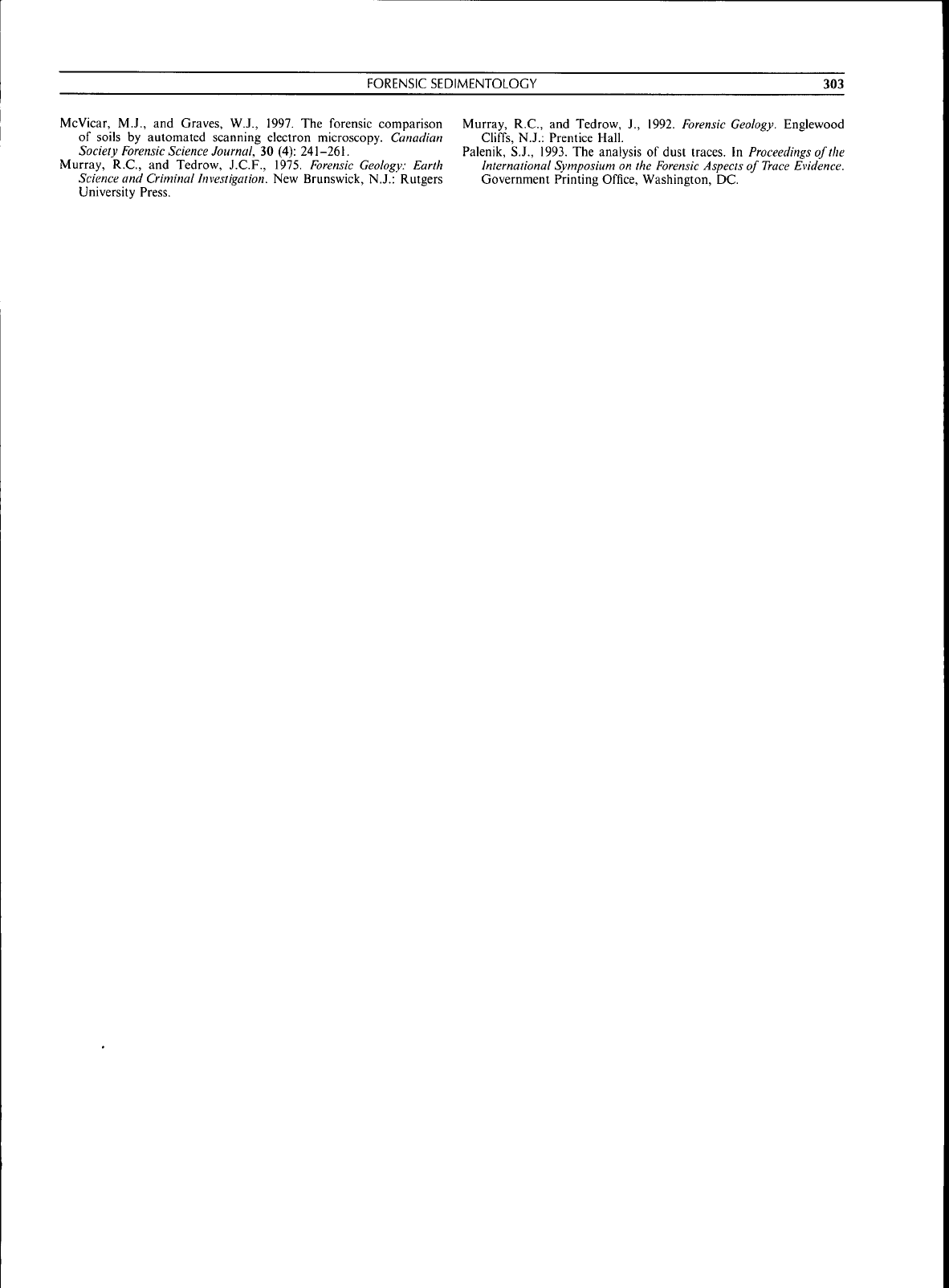
FORENSIC SEDIMENTOLOGY 303
McVicar, M.J., and Graves, W.J., 1997. The forensic comparison Murray, R.C., and Tedrow, J., 1992. Eorensic Geology. Englewood
of soils by automated scanning electron microscopy. Canadian Cliffs, N.J.: Prentice Hall.
Society
Forensic
Science Journal, 30(4):
241-261.
Palenik, S.J., 1993. The analysis of dust traces. In Proceedings of the
Murray, R.C., and Tedrow, J.C.F., 1975. Eorensic Geology: Earth International Symposium on the
Eorensic
Aspects of
Trace
Evidence.
Science and Criminal Investigation. New Brunswick, N.J.: Rutgers Government Printing Office, Washington, DC.
University Press.
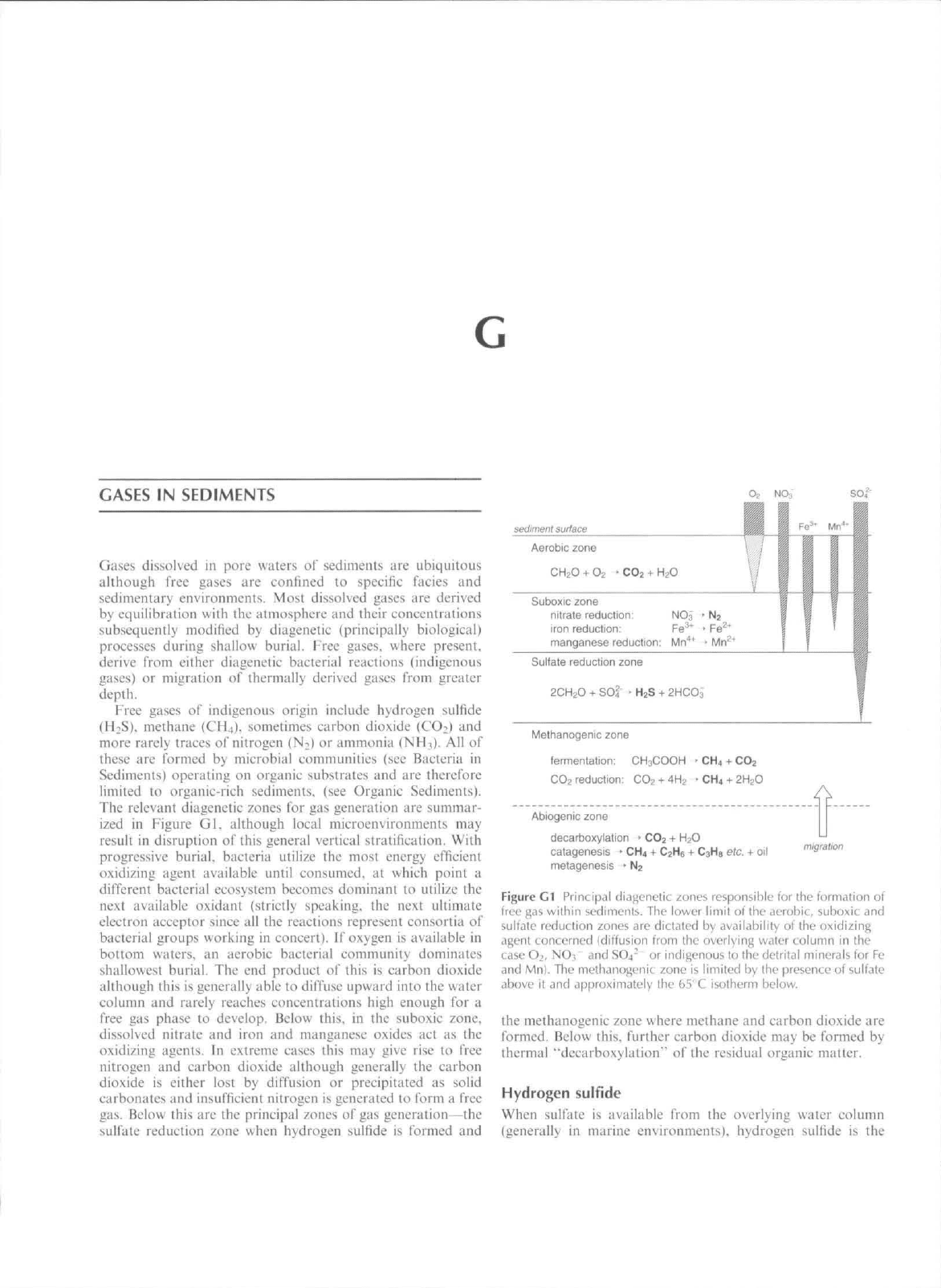
GASES IN SEDIMENTS
Gases dissolved in pore waters of sediments are ubiquitous
although free gases are confined lo specific facies and
sedimentary environments. Most dissolved gases are derived
by equilibration with the atmosphere and their concentrations
subsequently modified by diagenetie (principally biological)
proeesses during shallow burial. Free gases, where present,
derive from either diagenelic bacterial reactions (indigenous
gases) or migration of thermally derived gases from greater
depth.
Free gases of indigenous origin inelude hydrogen sulfide
(H2S).
methane {CH4). sometimes carbon dioxide (CO:) 'ind
more rarely traces of nitrogen (N^) or ammonia (NHi). All of
these are formed by microbial communities {see Bacteria in
Sediments) operating on organic substrates and are therefore
limited lo organic-rieh sediments, (see Organic Sediments).
The relevant diagenelie zones for gas generation are summar-
ized in Figure Gl, although local microenvironments may
result in disruption of (his general vertical stratification. With
progressive burial, bacteria utilize the most energy efficient
oxidizing agent available until consumed, at which point a
dilTerenl bacterial ecosystem becomes dominant to utilize the
next available oxidani (strictly speaking, the next ultimate
electron acceptor since all the reactions represent consortia of
bacterial groups working in eoneert). If oxygen is available in
bottom waters, an aerobic bacterial community dominates
shallowest burial. The end product of this is carbon dioxide
although this is generally able to diffuse upward into the water
column and rarely reaches concentrations high enough for a
free gas phase to develop. Below this, in the suboxic zone,
dissolved nitrate and iron and manganese oxides act as the
oxidizing agents. In extreme cases this may give rise to free
nitrogen and carbon dioxide although generally the carbon
dioxide is either lost by diffusion or precipitated as solid
carbonates and insufficient nilrogen is generated to form a free
gas.
Below this are the principal zones of gas generation—the
suifate reduetion zone when hydrogen sulfide is formed and
sediment surface
Aerobic zone
C02 +
HjO
Suboxic zone
nitrate reduction; NO3 • N2
iron reduction: Fe'^' • Fe
manganese reduction: Mn"^ • Mn
Sulfate reduction zone
2CH2O + 2HCO3
Methanogenic zone
fermenlalion: CH3COOH • CH4 + CO2
CO2 reduction: CO2 + 4Hj • CH4 + 2H2O
Abiogenic zone
decarboxylation • CO2 + H2O
catagenesis • CH4 + C2H6 + C3HB etc. + oil
metagenesis • Nj
migration
Figure Gl Principal diagenelic zones responsible tor the formation of
froe g.is within sedimenis. The lower limit of the jerubic, suboxic and
sultale reduction zone? are dictated by avail<ibility of the oxidizing
agent concerned (diffusion from the overlying wafer column in the
case Ol, NOi and SO4- ur indigenous to the detrital minerals for Fe
and Mn). The methanogenic zone is limited by the presence nf sulfate
above it and approximately the 65'C isotherm below.
the methanogenic zone where methane and carbon dioxide are
formed. Below this, further carbon dioxide may be formed by
thermal "deearboxylation" of the residual organie matter.
Hydrogen sulfide
When sulfate is available from ihe overlying waler column
(generally in marine environments), hydrogen sulfide is the
